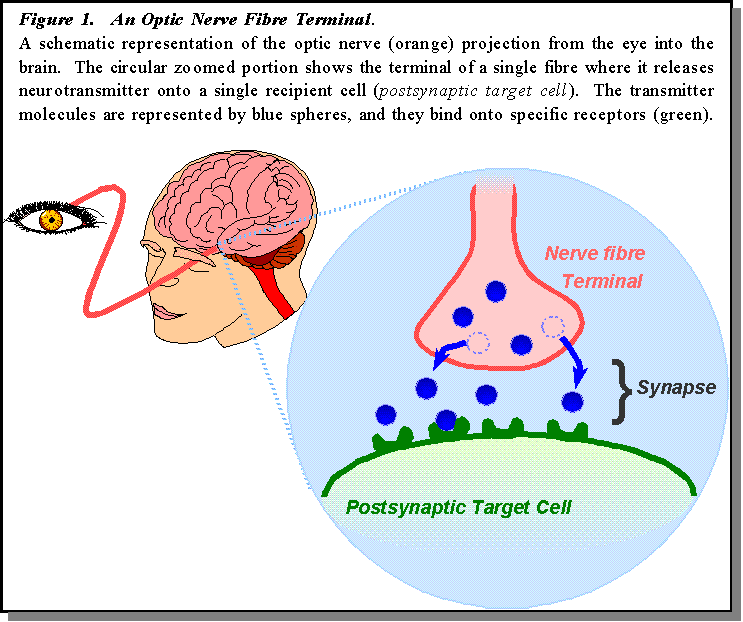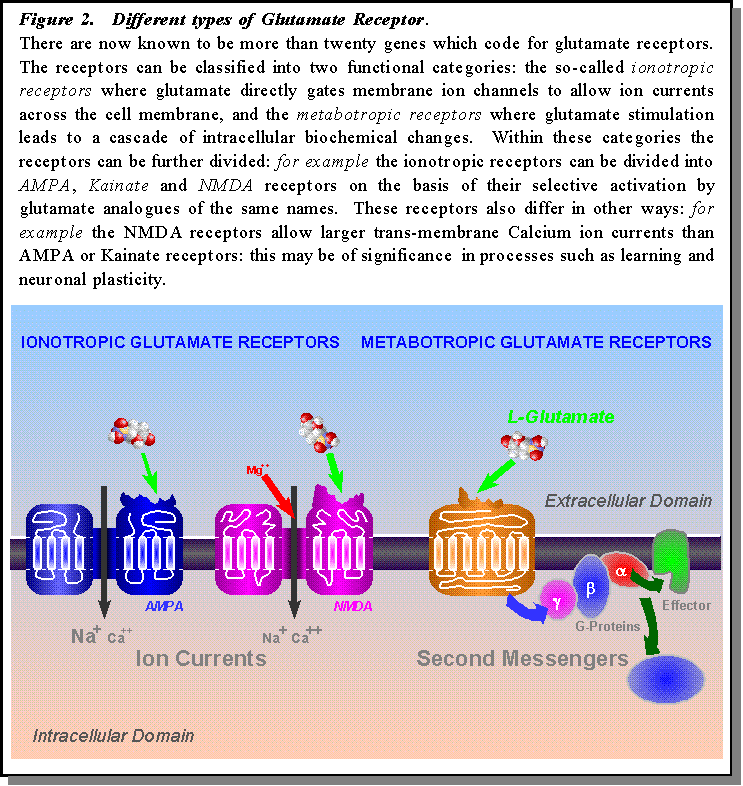
MAKING SENSE OF THE SOUP
One of the remarkable features of the brain is how the millions of cells in the brain communicate
specific messages to each other and how these messages are interpreted and acted upon by
recipient cells. For example, the human optic nerve, has about a million individual nerve fibres (or
axons) carrying information from the retina in the eye to the various parts of the brain where the
visual information is received and processed. The transfer of information from the terminals of
the nerve fibre onto the recipient cells occurs via the release of chemical messenger molecules
(called neurotransmitters) from the terminal: these molecules diffuse across a small gap (called
the synapse) and lock onto specific sites (called receptors) on the target cell (Figure 1).

What are the ingredients?
There are many dozens of different neurotransmitter chemicals in the brain, and probably more
which remain to be discovered. The identification of these has been the subject of work from
hundreds of laboratories around the world over many years. Some of these transmitters are
complex peptides, others are simple ubiquitous molecules. For example, the amino acid
L-glutamate, which is found throughout the body and in many foods is thought to be widely used
in the brain as a transmitter. Some nerve cells can release several different transmitters, and these
are thus present in the extracellular fluid, together with ions and other chemicals to form a
complex 'soup'.
For a nerve cell (or neurone), the key to making sense of this mixture of transmitters and other
materials is the receptor, which is located embedded across the cell membrane. The specific
interaction of the transmitter with the receptor, much like a key fitting into a lock, triggers a
cascade of chemical and electrical events within the cell. The precise nature of these
postsynapticchanges depends on the properties of the receptor. Thus one transmitter acting on
different receptors, or a combination of transmitters acting on several different types of receptor
can signal different types of information.
What's cooking in the lab?
The work of Tom Salt's research group is to elucidate the transmitter-receptor interactions
which underlie the transmission and processing of visual and other sensory information within the
brain.
One of the ways in which this can be done is by recording the electrical activity of single cells
from regions of the brain which receive input from the eye and other sensory systems. Applying
small amounts of transmitters and chemically-related compounds in the vicinity of these cells
whilst recording their activity enables us to compare the responses of these cells to their normal
input with the responses to the compounds which we apply. This allows us to draw conclusions
about the nature of the chemical transmission process. We are carrying this out in various
sensory-recipient parts of the brain, and also investigating how these processes change during
development and growth of the brain.
A particular focus of activity of this group has been the role of L-glutamate and its receptors in
transmission. A variety of these receptors exist, each having distinct characteristics (see Figure 2
for more details of glutamate receptors). This enables the transmission of information within
different time frames, from only several milliseconds to many minutes and beyond. Thus, for
example, the release of L-glutamate from the terminal of an optic nerve fibre onto target cells in
the brain can signal the start and end of a brief flash of light, leading to rapid electrical responses
in the target cell. However, this release can also set in motion a complex cascade of intracellular
events which can invoke long-term changes in the structure and function of the target cell.
In collaboration with colleagues at the Brain Research Institute of Zurich University we have
developed a unique method which allows us to record the activity of brain cells while measuring
the release of transmitter chemicals from the brain. This allows us to correlate the electrical
activity with the release of chemicals from cells in the brain.

Where is this leading ? (What may be on the menu?)
We are building up a complex picture of how the various transmitters which are present in sensory
structures of the brain are used under normal physiological conditions to signal visual and other
sensory information, and how this function may in turn be modified by other transmitters. This
fundamental understanding of how the system works is essential as a basis to understanding the
processes which may occur in disease and injury. For example, it is now known that some
neuro-degenerative conditions and injury responses in the brain involve changes in glutamate
metabolism, and the effects of these are mediated via glutamate receptors. Thus, the use of drugs
which block the action of glutamate selectively at some of its receptors could be hypothesised to
counteract some of these pathological responses, thereby reducing cell damage and degeneration.
It is known that as the brain develops and grows that specific nerve connections are made and
maintained whilst other connections are lost: this depends on the neurotransmitter actions at the
appropriate synapses. Some of the glutamate receptors (The so-called NMDA receptors and
metabotropic receptors - see Figure 2) are implicated in these plastic phenomena, and we have
been investigating how their function changes and how it may be modified by visual experience.
This promises to reveal the conditions under which plasticity in the visual pathway can be
maintained or even induced: this would open up the possibility whereby modulation of "molecular
switches" with specific drugs could allow or facilitate the regeneration of damaged pathways.
Thus the study of fundamental biological and chemical processes in the brain lays the foundations
for future potential treatments of neurological disorders.
This page was written by Tom Salt, and is part of the Neurotransmitters in Sensory Systems Home Page.
 |